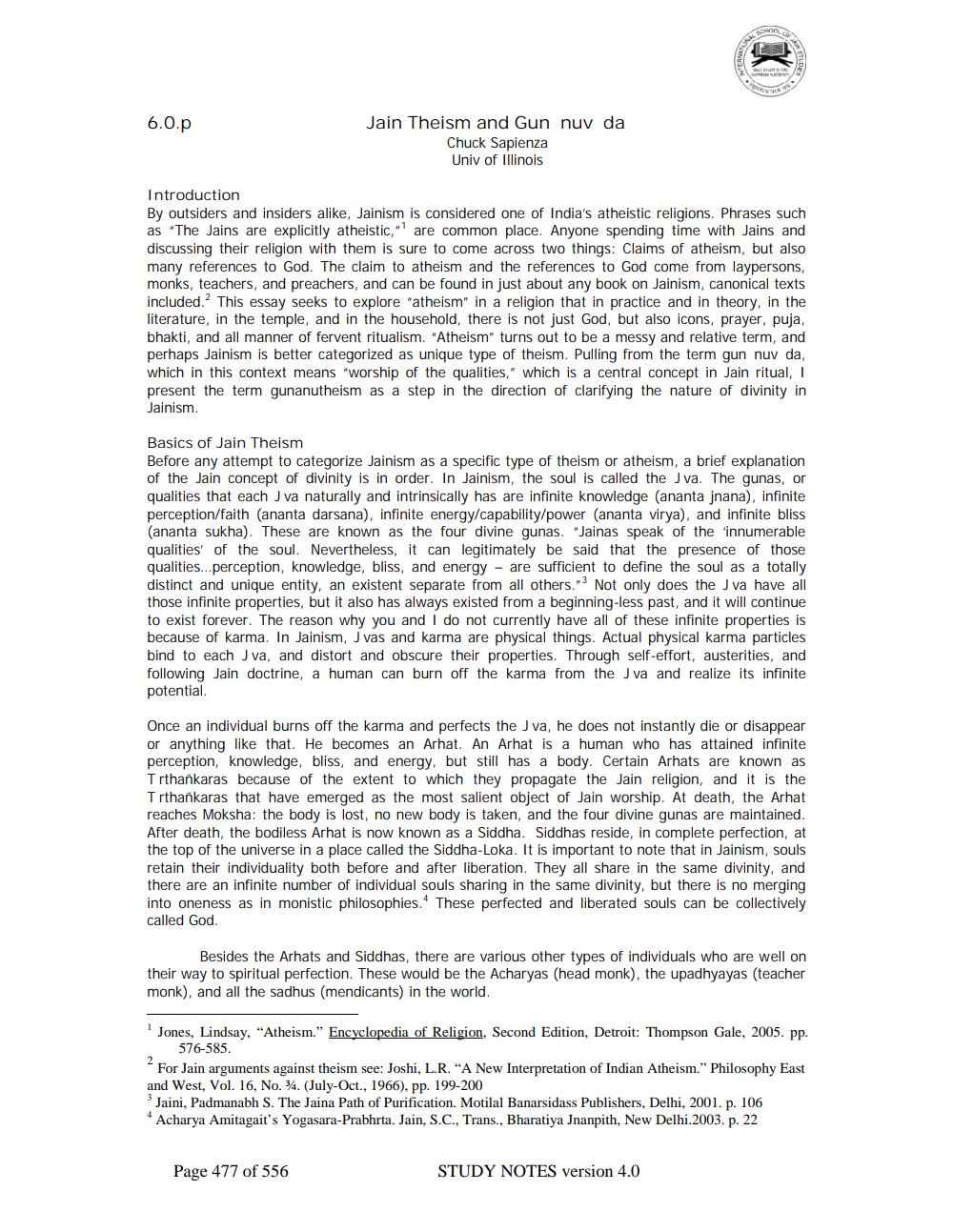________________
6.0.p
Jain Theism and Gun nuv da
Chuck Sapienza Univ of Illinois
Introduction By outsiders and insiders alike, Jainism is considered one of India's atheistic religions. Phrases such as "The Jains are explicitly atheistic, are common place. Anyone spending time with Jains and discussing their religion with them is sure to come across two things: Claims of atheism, but also many references to God. The claim to atheism and the references to God come from laypersons, monks, teachers, and preachers, and can be found in just about any book on Jainism, canonical texts included. This essay seeks to explore "atheism" in a religion that in practice and in theory, in the literature, in the temple, and in the household, there is not just God, but also icons, prayer, puja, bhakti, and all manner of fervent ritualism. "Atheism" turns out to be a messy and relative term, and perhaps Jainism is better categorized as unique type of theism. Pulling from the term gun nuv da, which in this context means "worship of the qualities," which is a central concept in Jain ritual, I present the term gunanutheism as a step in the direction of clarifying the nature of divinity in Jainism.
Basics of Jain Theism Before any attempt to categorize Jainism as a specific type of theism or atheism, a brief explanation of the Jain concept of divinity is in order. In Jainism, the soul is called the J va. The gunas, or qualities that each J va naturally and intrinsically has are infinite knowledge (ananta jnana), infinite perception/faith (ananta darsana), infinite energy/capability/power (ananta virya), and infinite bliss (ananta sukha). These are known as the four divine gunas. "Jainas speak of the 'innumerable qualities of the soul. Nevertheless, it can legitimately be said that the presence of those qualities...perception, knowledge, bliss, and energy - are sufficient to define the soul as a totally distinct and unique entity, an existent separate from all others." Not only does the J va have all those infinite properties, but it also has always existed from a beginning-less past, and it will continue to exist forever. The reason why you and I do not currently have all of these infinite properties is because of karma. In Jainism, J vas and karma are physical things. Actual physical karma particles bind to each J va, and distort and obscure their properties. Through self-effort, austerities, and following Jain doctrine, a human can burn off the karma from the J va and realize its infinite potential
Once an individual burns off the karma and perfects the J va, he does not instantly die or disappear or anything like that. He becomes an Arhat. An Arhat is a human who has attained infinite perception, knowledge, bliss, and energy, but still has a body. Certain Arhats are known as Trthankaras because of the extent to which they propagate the Jain religion, and it is the Trthankaras that have emerged as the most salient object of Jain worship. At death, the Arhat reaches Moksha: the body is lost, no new body is taken, and the four divine gunas are maintained. After death, the bodiless Arhat is now known as a Siddha. Siddhas reside, in complete perfection, at the top of the universe in a place called the Siddha-Loka. It is important to note that in Jainism, souls retain their individuality both before and after liberation. They all share in the same divinity, and there are an infinite number of individual souls sharing in the same divinity, but there is no merging into oneness as in monistic philosophies. These perfected and liberated souls can be collectively called God.
Besides the Arhats and Siddhas, there are various other types of individuals who are well on their way to spiritual perfection. These would be the Acharyas (head monk), the upadhyayas (teacher monk), and all the sadhus (mendicants) in the world.
Jones, Lindsay, "Atheism." Encyclopedia of Religion, Second Edition, Detroit: Thompson Gale, 2005. pp.
576-585 For Jain arguments against theism see: Joshi, L.R. "A New Interpretation of Indian Atheism." Philosophy East and West, Vol. 16, No. 34. (July-Oct., 1966), pp. 199-200
Jaini, Padmanabh S. The Jaina Path of Purification. Motilal Banarsidass Publishers, Delhi, 2001. p. 106 * Acharya Amitagait's Yogasara-Prabhrta. Jain, S.C., Trans., Bharatiya Jnanpith, New Delhi.2003. p. 22
Page 477 of 556
STUDY NOTES version 4.0




